Japan
Wood Products Prices
Dollar Exchange Rates of 25th
Sep
2023
Japan Yen 149.30
Reports From Japan
Removing hurdles
faced by foreign companies
investing in Japan
To boost foreign investment in Japan the government is
considering a policy package to revise laws in order to
relax regulations on foreign investment, address Japan's
‘unique’ business practices and ease hurdles faced by
foreign companies wishing to enter the Japanese domestic
market. Part of this plan may involve setting up special
economic zones tailored where administrative procedure
can be completed solely in English.
In related news, a survey by Kyodo News found that 86%
of municipalities in Japan are facing a serious shortage of
workers in farming and other key sectors because of the
aging population and declining birthrate. To address this
municipalities want to see an increase in foreign workers.
See:
https://english.kyodonews.net/news/2023/09/09627910f55e-japan-pm-vows-to-set-up-special-zones-to-boost-foreign-investment.html
and
https://english.kyodonews.net/kyodo_news
No policy shift (yet) by Bank of Japan
At its end of September policy board meeting the Bank of
Japan (BoJ) decided to maintain the ultra-low interest rates
and reaffirmed its commitment to monetary easing despite
market expectations it could be preparing for a policy
shift.
The September meeting was the first since BoJ Governor,
Kazuo Ueda, alluded to the possible ending of the Bank’s
negative interest rate policy if prices and wages rise. The
latest decision means the BoJ will continue moving in a
opposite direction to the US Federal Reserve and the
European Central Bank which are raising interest rates to
tame inflations. The BoJ said inflation expectations are
rising but it is not convinced on the sustainability of wage
growth, an essential if interest rates are to be lifted.
See:
https://mainichi.jp/english/articles/20230922/p2g/00m/0bu/020000c
August trade deficit
Data from the Ministry of Finance for August show that
Japan recorded a trade deficit of over US$6 billion largely
because of the imposition of trade restrictions especially
by China which led to the biggest drop in food exports to
China in 12 years and the cost of imports, especially
energy, surged.
China imposed an import ban on Japanese seafood in late
August, after the operator of the crippled Fukushima No. 1
nuclear power plant began releasing treated radioactive
water into the Pacific Ocean. Food exports to China
tumbled 41.2% from a year earlier to ¥14.19 billion .
Japan's overall exports to China dropped 11.0% to ¥1.44
trillion while imports decreased 12.1% to ¥1.93 trillion,
leading to a ¥493.09 billion trade deficit.
See:
https://www.japantimes.co.jp/business/2023/09/20/august-exports-fall/
Worker shortage a risk to economic security
The Japanese government is becoming increasingly
concerned about a looming worker shortage which is seen
as yet another risk to economic self-reliance and economic
security.
This concern comes at a time when the sustainability of
wage growth is the focus of attention because of the
efforts being made by the Bank of Japan (BoJ) to achieve
a steady 2% annual inflation.
If the BoJ target is to be achieved it will be necessary for
the government to convince the private sector that annual
wage increases must be higher than the country's inflation
rate. This will be a major challenge as Japan's widespread
seniority-based employment system, low labour
productivity and worker reluctance to move from one job
to another have been among the factors behind the slow
wage growth for years.
Shipping captured carbon dioxide – discussions with
Malaysia
Japan is discussing with the Malaysian government a
proposal for shipping captured carbon dioxide to Malaysia
for underground storage as part of an Asian
decarbonisation project.
The project, if implemented, will be Japan's first shipment
and storage of captured carbon dioxide and could begin in
2028. Japan and several Southeast Asian countries plan to
build an Asia-wide carbon dioxide capture, utilisation and
storage network by 2030 in hopes of achieving
decarboniation and economic growth simultaneously in
the region.
See:
https://www.japantimes.co.jp/business/2023/09/26/economy/japan-carbon-capture-storage/
Rise in household assets
Assets held by Japanese households hit a record US$14
trillion at the end of June this year, an almost 5% rise from
a year earlier. Stock holdings surged 26%. Cash and
deposits, which accounted for over half of total household
assets, were up 1.4%. Despite the rise in overall assets
consumers are still very cautious on the future direction of
the economy so personal consumption is subdued.
See:
https://mainichi.jp/english/articles/20230920/p2g/00m/0bu/026000c
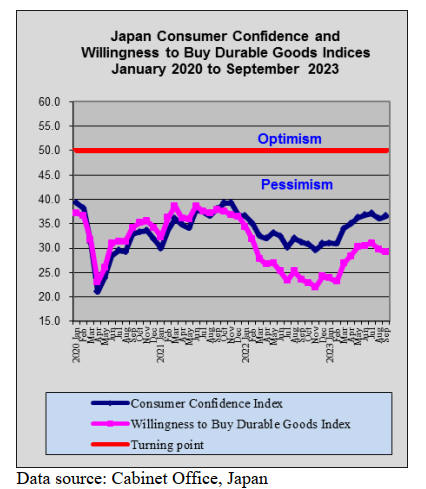
Smaller cities see land price rise
This year average land prices outside of the three largest
metropolitan areas in Japan rose for the first time in over
30 years on the back of sharp increases in land prices in
the smaller cities such as Sapporo, Sendai, Hiroshima and
Fukuoka which saw an 8% increase. In these and other
smaller cities recent redevelopment investment has
attracted residents and businesses to these cities.
Of 38 regional prefectures, 27 recorded a decline in their
overall land prices. However, 20 prefectures saw the
figures increase or remain unchanged in their capitals.
However, these increases are exceptions as land prices
have been declining in most regional areas.
See:
https://www.asahi.com/ajw/articles/15009758
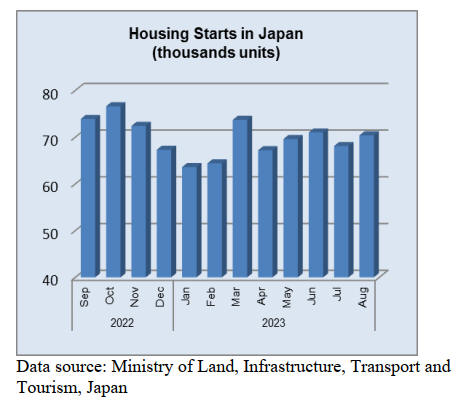
Yen closing in on 150 to the US dollar
If the Japanese yen weakens beyond 150 to the dollar as it
appears likely to do so in the coming weeks the BoJ could
be forced into changing its policy stance earlier than it
wishes. The yen slipped to 148.2 in the third week of
September after reaching its lowest in almost 10 months at
148.47 to the US dollar.
As the yen weakens overseas tourists are benefitting and
Japan has become a more affordable destination. Chinese
tourists, known for their shopping sprees, are back in
Japan. The weak yen, which remains close to multi-decade
lows, has delighted exporters but it has hurt domestic
household budgets as the cost of imports continues to
surge.
.
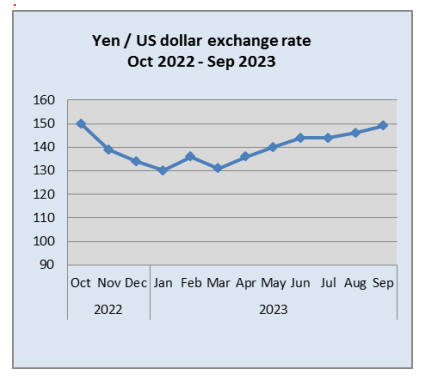
Import update
There was a decline in the value of Japan’s wooden
furniture imports in July compared to a month earlier.
Year on year there was a considerable fall in the value of
imports which, if set against the yen exchange rate which
has fallen from around 130 a year ago to 147 to the US
dollar in September, signals a significant downturn in
wooden furniture imports.
Expanding outside of Japan
Japanese furniture company Nitori Holdings has opened
its first outlet in Hong Kong and by 2032 it plans to have
20 outlets in Hong Kong. Nitori already has 75 locations
in mainland China and hopes to expand that to lift that to
100 by the end of the year. Nitori manufactures most of its
goods in mainland China and in Southeast Asia.
See:
https://asia.nikkei.com/Business/Retail/Japan-furniture-retailer-Nitori-plans-20-Hong-Kong-outlets-by-2032
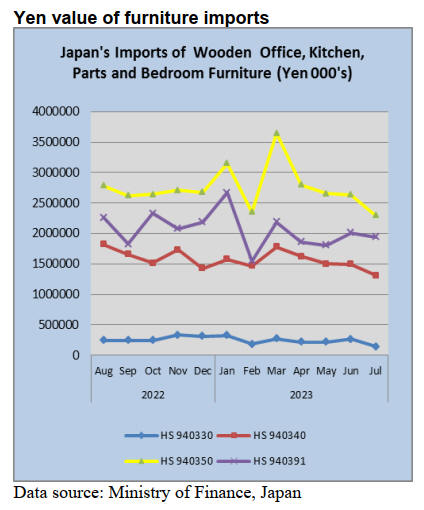
July wooden office furniture imports (HS 940330)
The value of Japan’s wooden office furniture imports in
July this year was 47% down compared to June and down
over 40% compared to July 2022. July shipments of
wooden office furniture from China accounted for 75% of
all shipments of wooden office furniture, down from the
84% share in June.
Of the other 18 July shippers Romania and the UK were in
the top five suppliers. There appears to have been a
diversification of sources of wooden office furniture in
July with several new shippers being identified in the
import statistics. Indonesia, Finland and Poland stand out
as accounting for around 3% each of July arrivals.
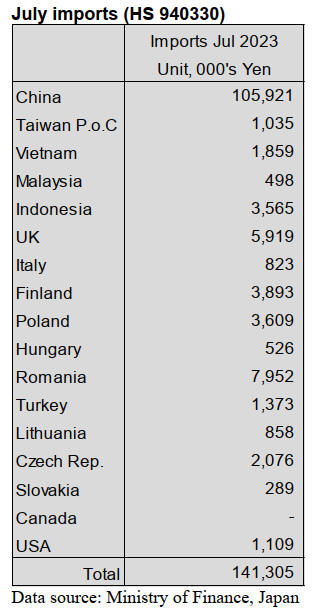
July kitchen furniture imports (HS 940340)
Two suppliers, the Philippines and Vietnam, continue to
dominate Japan’s imports of wooden kitchen furniture but
in July the value of shipments to Japan from these two
main suppliers declined which drove down the total value
of arrivals of wooden kitchen furniture despite the rise in
the value of imports from China, Malaysia and Indonesia.
Year on year the value of wooden kitchen furniture
imports dropped 28% and month on month there was a
12% decline. The value of Japan’s imports of wooden
kitchen furniture was falling for four consecutive months
up to July.
In July shipments from the Philippines accounted for 48%
of the value of imports of HS940340 with a further 33%
coming from Vietnam. The other shippers of note in July
were China and Italy.

July wooden bedroom furniture imports (HS 940350)
Since April this year there has been a steady reduction in
the value of imports of wooden bedroom furniture. China
and Vietnam are the largest suppliers of wooden bedroom
furniture to Japan together accounting for around 90% of
imports of this category of wooden furniture. The decline
in the value of imports from these two main shippers
disguises the advances made in market share by some
other shippers such as Malaysia and some EU member
states.
In July this year there was an 18% decline in the value of
wooden bedroom furniture and month on month the
decline was in the order of 12%.

July wooden furniture parts imports (HS 940391)
Year on year the value of Japan’s imports of wooden
furniture parts dropped 14% and there was a 4% decline
compared to the value of June imports. The top suppliers
in July were, as in previous months, China (44%),
Indonesia 21%, Malaysia (11%) and Vietnam 7%. For the
past four months the value of wooden furniture parts
imports has been within a narrow range and the decline in
the overall value of imports has been felt by all of the
main shippers.
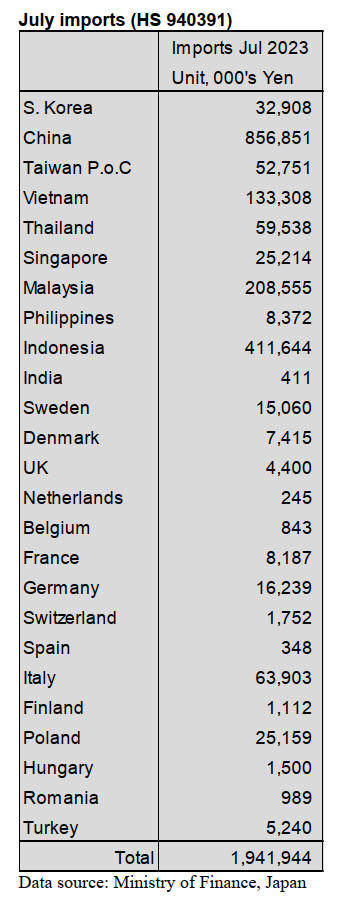
Trade news from the Japan Lumber Reports (JLR)
The Japan Lumber Reports (JLR), a subscription trade
journal published every two weeks in English, is
generously allowing the ITTO Tropical Timber Market
Report to reproduce news on the Japanese market
precisely as it appears in the JLR.
For the JLR report please see:
https://jfpj.jp/japan_lumber_reports/
Demand and supply of lumber at Tokyo port
Inventory of lumber at Tokyo port in August, 2023 is
119,000 cbms and it is 3,500 cbms more than July, 2023.
The inventory has been decreasing since September, 2022
but it stops decreasing. Arrival volume of Canadian
lumber in August declines due to the strike at a harbor in
Canada but the inventory of lumber keeps a level of
110,000 cbms. Shipment in August is almost the same
shipment in July. The inventory was 209,000 cbms in
August, 2022 and it is 43.1 % down in August, 2023.
Plywood supply for the 1st half of 2023
The supply of plywood in the first half of 2023 decreased
from the first half of 2022. A total plywood supply is
2,116,000 cbms, 28.2 % lee than January to June, 2022.
Domestic plywood is 1,188,000 cbms, 23.9 % less and
imported plywood is 927,000 cbms, 33 % less than the
same period last year.
Product of domestic plywood in June, 2023 is 9.4 % up
from May 2023 and it is 19.4 % less than June, 2022. The
anticipation of falling prices is about to calm down
because the price of 12 mm 3 x6 structural softwood
plywood almost reached the bottom in Eastern and
Western Japan in July, 2023. The price was 1,600 yen,
delivered per sheet. However, demand of houses has been
low so the shipment of plywood in the future remains
unclear.
Imported plywood in June, 2023 is 38.2 % down from
June, 2022. Malaysian plywood in January to June, 2023
is 40 % less than June, 2022. Indonesian plywood at the
first half of 2023 is 196,000 cbms, 37.2 % down from the
first half of 2022. Indonesian plywood in June, 2023
increases slightly from May, 2023 and it is 30.4 % down
from June, 2022.
Demand and supply of domestic softwood plywood in
the 1st half of 2023
Product of domestic structural softwood plywood is 25.3
% down from January to June, 2022. The reason is that
plywood manufacturers have been reducing product to
control demand and supply since last October.
Since the housing market is sluggish, shipment of
domestic structural softwood plywood is 24.8 % less than
January to June, 2022. However, shipment of domestic
structural softwood plywood in June, 2023 is 5.9 % up
from May, 2023. Inventory of domestic structural
softwood plywood in June, 2023 is 138,629 cbms, 82.7 %
more than June, 2022.
Orders for house builders
New orders for many house builders in July, 2023 rise by
4 % from July, 2022. However, the results of July, 2022
were low so it is hard to say that this situation is good.
Many house builders do not get a strong sense of recovery
in orders and they have no idea that this situation would be
better in the future. Some house builders have a good
result by non-housing buildings. The price of a house is
lowered but starts of house still do not increase. The price
of lumber is decreasing but other materials for building
structures are high.
South Sea logs and lumber
South Sea log such as Keruing for producing lumber is
about to run short. Demand of South Sea log shipbuilding
and steel companies have been strong until June, 2023 and
other demand has been low so demand and supply has
been balanced. However, demand for truck bodies
increased suddenly. Then, some distributors import South
Sea logs by container ships hurriedly.
Inquiries for truck bodies were very low last year. One of
the reasons is that the semiconductors were short. The
other reason is that a major commercial vehicle company
in Japan did wrong on engines and the sales were not
good. However, a shortage of semiconductors had solved
after April, 2023 and the sales rose. Then, demand of truck
bodies recovered in June.
It takes three to four months to import South Sea lumber
from overseas so South Sea lumber companies in Japan
got orders. Thus, South Sea lumber companies in Japan do
not have enough South Sea logs and they make every
effort to get South Sea logs.
Movement of South Sea lumber and Chinese lumber is
sluggish due to low demand in Japan and the weak yen.
The sales of trucks are not good even though product of
truck body recovered. It is unclear that how long this
situation would continue.
|